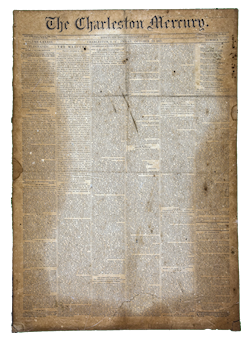May 21, 1863, The Charleston Mercury
We make some interesting extracts from a sketch of the late battles on the Rappahannock, communicated to the Columbia Carolinian by a correspondent in the army:
Next morning early the firing was resumed. Our infantry began to press forward in earnest, and our artillery, which had succeeded in getting a position on our left, opened a terrific fire. From our right, too, a constant fire was kept up. From our centre, too, a battery connected with Mahone’s brigade fired through the woods, without being able to see the enemy position. A man was put up in the top of a tree, and he would direct them to fire to right or left or higher or lower, as he thought proper. In this way it rendered effective service. Whenever the man up the tree would say, ‘That’s it, now you have the range,’ a rapid fire would be kept up until that party was dispersed. Then the man up the tree would direct them upon another crowd. Steadily the terrific roar contracted around Chancellorsville, and we knew that our troops were pressing all opposition before them. Then comes the order for the centre and right, under Anderson and McLaws, to close in upon the enemy. The obstacles in front of these two divisions were of such a formidable character, that it was not deemed prudent to urge an attack from these points. Once, however, during Saturday, the enemy made an attempt to pass between General Anderson’s left and General Jackson’s right. But a prompt and skillful disposition of his men by General Anderson, speedily checked and counteracted it. It was in this movement, I suppose, that the enemy came near getting among some of Jackson’s wagons, but were driven off by the 8th South Carolina Regiment, which was temporarily detached from Kershaw brigade. It was this that gave rise to the rumor that the 8th had been captured. There was no foundation for the rumor, other than this. The gallant old 8th lost not a man killed or prisoner. As Anderson’s division closed in upon the enemy, McLaws swung around with it, and the roar of artillery and rattle of musketry surpassed anything I ever heard, on any battle field. In this battle there was a great deal of very heavy skirmishing. Early Sunday morning, the companies on outpost were relieved, and Captain G. B. Cuthbert, of the Second South Carolina Regiment, put in command of the brigade skirmishers. With his accustomed dash and impetuosity, he ordered an advance, and was pressing with imprudent daring upon the breastworks, when he was shot down. The enemy’s works circled around the brow of a hill, and Captain Cuthbert had pressed forward until he was at the foot of the hill. He was struck in the breast, the surgeons being of the opinion that the ball ran around under the skin and came out at his back. He thought it perforated his lungs. The skirmishers were still more increased to thirteen companies, and Major Gaillard ordered to take command. He found Capt. Cuthbert not killed, as was reported, and as was supposed, but wounded, as above described. Though believing himself to be mortally wounded, he yet gave to this officer relieving him a very clear, concise and calm statement of his orders, and what he had done. He was then borne to the rear by the Ambulance Corps. Gradually our lines past forward, and every minute prisoners were coming in and being sent to the rear. Closer and closer the fire contracted upon Chancellorsville, until our line emerged from the woods, the last battery of the enemy was silenced and deserted, and dead horses, dead Yankees, prisoners, scattered guns, broken caissons and abandoned artillery, was all that could be seen of the defiant host that a short time before had so stoutly resisted our advance. The large brick tavern at Chancellorsville, constituting in itself the villa, was in flames, having been fired by our shells. There is no doubt that a large number of wounded men were burnt in it – the enemy having used it as a temporary hospital. Fire was also communicated to the woods, and a number of wounded men on both sides were, I am credibly informed, burnt in them also. An immense number of horses were killed around the place by our artillery. The trees were riddled and torn – the breastworks knocked up by the enfilade fire from our left. Here could be seen, too, all the frightful and ghastly wounds of heavy ordnance. To give it full justice, I must say that our artillery ably supported the infantry at this battle. A remark that cannot often be made.
